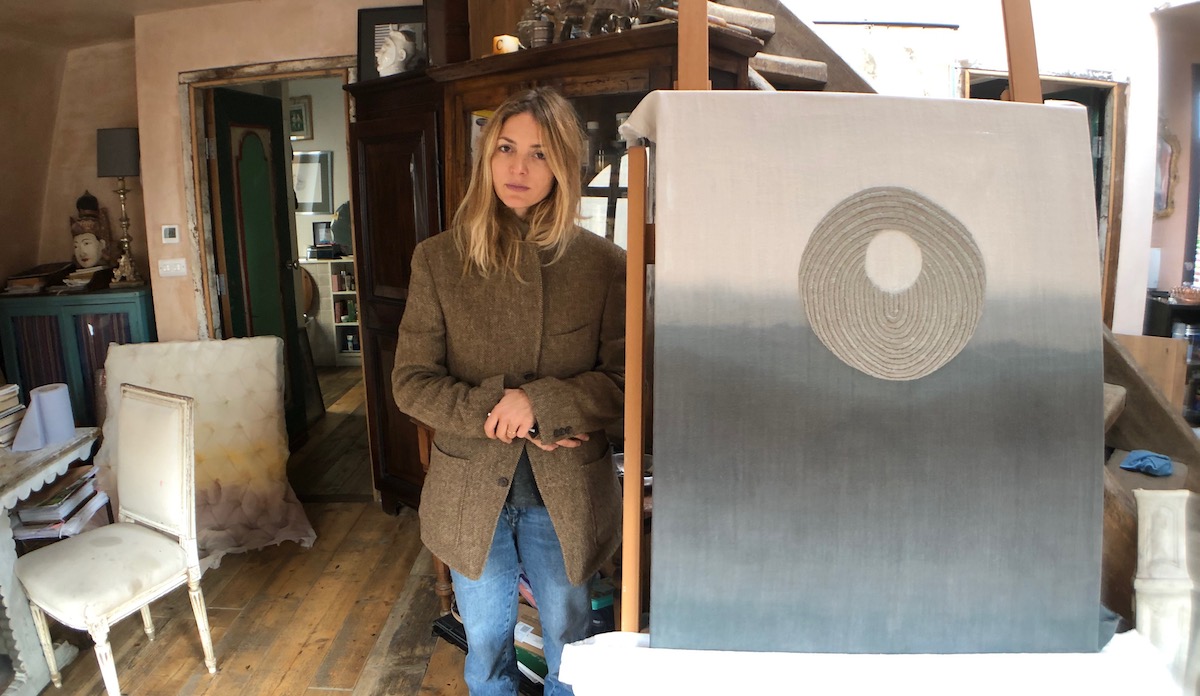Carolina Mazzolari is one of the key artists currently in an exhibition and auction sale at Sotheby’s to benefit Fine Cell Work, a charity and social enterprise working with prisoners.
Carolina trained as a textile artist at Chelsea College of Art. She concentrated on dyeing techniques and screen printing. Following the completion of her degree in 2003, Mazzolari opened her art studio in Milan while working as Head Designer, specialist in Textiles. Living and working in London since 2014, her multidisciplinary practice involves textile manipulation, printing, painting, photography, video and performance. She is inspired by psychoanalysis, intuition, cognition, human behaviour and emotional development. She is married to the artist Conrad Shawcross.
Paul Carter Robinson: How do you describe your practice?
Carolina Mazzolari: I think it’s a mix of a heritage of skills that are put together. I have fused my abilities as a fashion/textile designer to make fine art and create a new alphabet. I apply all of these practices to make something that is my own. I always considered myself an artist as well as a designer.

CM: These past few months, I have been creating a very large tapestry. I see it as painting it discloses symbols like an ancient tapestry. It takes a long process to make. I always start with a blank canvas. I draw on things and usually, I dye first.
PCR: Do you use natural dyes?
CM: Yes sometimes I do, but I’ve been a bit unhappy with the results as they take masses more water and I need to use loads of fixative, so they are a bit less good for the environment as a result. With chemical dyes, I can use them in a pure form and need just a little. They dry up the water and the result is better.
PCR: The embroidery in your work is this a carry-over from your time as a fashion/textile designer?
CM: I was in Mexico visiting collectors. I made up my mind that I didn’t want to contribute any longer, to fast production. It just didn’t agree with me anymore. I also wanted to apply all my skills to just making art. Embroidery is part of this.
PCR: Your series of moon tapestries are by far your simplest compositions would you tell us a little bit about them.
CM: These are quite minimal works. They represent a rising moon and a setting moon. The sphere is in just two colours; reflections are so powerful on their own. It takes around a thousand hours of stitching to create. I wasn’t looking to Eastern Art; there is some influence in its essence.
PCR: Is there a landscape lurking in there as well?
CM: I see the sea in there and clouds, but everyone sees something different in these works.

PCR: So this next tapestry is a figurative work?
CM: Yes, I call this one my big sketch. It was part of the big tapestry show at Palazzo Zaguri at the Venice Biennale. It was a mad show. They gave me a beautiful room just by the exit.
PCR: Was this your breakthrough piece?
CM: I started making tapestries in 2016. I was making this one on the floor and Conrad said ‘to me, ‘You are really going somewhere with ‘his one’ and just a couple of years later my work has evolved from this piece.
PCR: There is so much depth to the work with the embroidery
CM: In the beginning, I wanted to add a third dimension into a painting I had the idea and started to pile up the acrylic paint in layers, but now I use the embroidery to do the same.
PCR: What did you think of the Annie Albers exhibition at the Tate?
CM: She is more of a weaver. I studied her work when I was at university. She has been one of my influences, but she is more of a weaver. She uses her craft to make Abstract Art; this is where it is similar to what I do.
CM: In my work, I have collaborated with convicts. They have helped me create the biggest pieces. Fine Cell Work has put one of my pieces into an auction at Sotheby. I wanted to give this one to them because it is stitched by myself together with two very talented women prisoners, the stitching is so beautiful and shiny and reflects the light in a very particular way. The stitcher was recently released and sent back to Malaysia.
PCR: Why was she in prison if she was from Malaysia? Don’t I don’t know. The problem is there is only a small amount of information that you get. At the beginning of our relationship, I was meant to go there to the prison to see them and talk to them. But now all of my best stitchers are in high-security prisons so we cannot have contact with them. I know that Ben, who worked with Cornelia Parker and with Idris on this particular project is incredibly talented. They have a long stretch to develop their skills as embroiders. It becomes the only creative/productive thing. You know they are trapped in very grey buildings. There is no nature. The only colour they see is when they embrace these kinds of projects. So you can see they put everything into the work and it comes back and I’m astonished at the results.
Other artists participating in the Fine Cell Work exhibition
Ai Weiwei | Idris Khan | Carolina Mazzolari | Annie Morris | Cornelia Parker | Bob and Roberta Smith | Wolfgang Tillmans | Francis Upritchard
All proceeds will go to Fine Cell Work, working to enable prisoners across Britain to build fulfilling and crime free-lives by training them to do high-quality creative needlework and thereby helping to foster hope, discipline and self-esteem.
Words/Top Photo: Carolina Mazzolari by Paul Carter Robinson © Artlyst 2019
Fine Cell Work at Sotheby’s London Galleries until 3 March 2020

